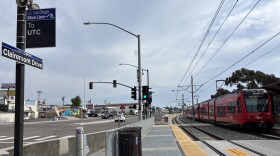The state’s two largest utilities routinely drag their feet connecting solar panels to the electric grid, missing state-mandated deadlines as much as 73% of the time, according to a complaint filed to regulators by solar advocates.
The complaint filed by a solar energy advocacy group urges the California Public Utilities Commission to hold utilities accountable when they fail to meet such deadlines. The commission is formally reviewing it.
The advocates have complained for years that such delays hinder California’s transition to renewables. State utility regulators are separately revisiting the process for connecting rooftop solar to the grid, including examining whether and how the utility commission should require utilities to comply with the timelines it established years ago.
But the commission has yet to reprimand utilities for regularly missing these deadlines.
“The rule is there, but the commission hasn’t chosen to enforce it,” said Kevin Luo, policy and market development manager for the California Solar & Storage Association, a group advocating for the adoption of solar energy that filed the complaint.
When Californians add solar panels to their rooftops, they begin a complex “interconnection” process led by the utilities to ensure the array is correctly installed and able to provide power for both the customer and the grid, which receives power the customer does not use. For each interconnection step, the utility is allotted a certain amount of time, ranging from five business days to 90 calendar days.
The timelines for several of the more extensive steps – including design, construction and installation – were clarified in a 2020 decision after solar panel owners complained that California’s major investor-owned utilities were blowing their deadlines.
The delays can have significant financial consequences for panel owners, widening the period after they have laid out money for solar cells but before they see a reduction in their power consumption or payments from selling excess solar power back to utilities.
Pacific Gas & Electric, Southern California Edison, and San Diego Gas & Electric all report their compliance with these timelines on a quarterly basis. The reporting is for projects over 30 kilowatts, which are often for businesses, not residential homes, and account for the majority of solar projects.
These data show that PG&E and Edison routinely exceed the allotted windows.
In the complaint, filed in late August, the California Solar & Storage Association noted the utilities take longer than permitted to connect customers between 19% and 73% of the time, depending on which stage of the process is examined.
For example, the utilities are given 10 business days to acknowledge someone’s request for interconnection – PG&E’s median time for this step was 20 days, with its longest being 245 days. One of the most crucial steps is a system impact study, which looks at how the addition of a customer’s solar array will affect the grid and identifies any potential issues with hookup. PG&E kept to its timeline 49% of the time, while Edison met its deadline 43% of the time, according to the complaint.






